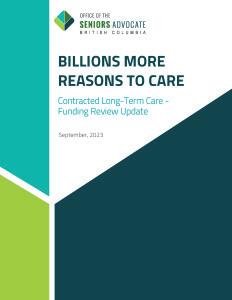
5 minute read
GETTING SENIORS’ CARE BACK ON TRACK
contractor. There was no way to get the contracted workers back under the master agreement.
Jennifer Reitan, now an occupational health and safety steward at her local, has represented members on the bargaining committee.
She says that when her employer withdrew from the HEABC, “we got pulled out of the municipal pension plan immediately. And when we went to bargain a new contract, the employer suddenly told us they were operating at a loss, and we had to take cuts.
“But we couldn’t afford to lose it all from our wages. So, we also took less holidays, less sick time, a different benefit package.”
Once her workplace was removed from the FBA agreement, she says, her sense of connection with other long-term care facilities slipped away.
And without the direct administration of the health authority, Reitan felt there wasn’t much oversight for her small care home in the Kootenays.
“We all just went under the radar, I guess. It felt like we were just part of a whole bunch of little facilities.”
Within a decade, the seniors’ care sector was utterly fragmented.
Wages for care aides varied by as much as $7 an hour, standards of care were hard to measure, and there seemed to be no clear system in place to track the public money given to private companies –how much they spent on care, and how much they took as profit.
When the BC NDP regained power in 2017, they restored succession rights to health care workers, and repealed the Liberal legislation that allowed workers to be fired when operators switched contractors.
This brought some stability to the sector for workers, but did not address the deterioration and disparity in care and working conditions created by 16 years of privatization.
In a series of reports, the B.C. Office of the Seniors Advocate found that for-profit operators were spending far less on frontline staff and delivering fewer hours of care than their not-for-profit counterparts.

A 2021 report linked lack of paid sick leave and the contracting out of care staff to some of the largest COVID-19 outbreaks in B.C.’s long-term care and assisted living homes.
The pandemic also accelerated a staffing crisis that had been gathering steam.
“Before the pandemic,” Reitan says, “we were still managing. If you’ve only worked in a private facility, you just accept the conditions, the struggles you have with equipment, and wages.
“But if you also work at Interior Health, you see the differences.
“When COVID hit, it was eye-opening to see all those people that left private facilities or chose to work … [in an] Interior Health site. We never got those people back.”
The wage-levelling program the B.C. government introduced during the pandemic subsidized private facilities so they could maintain staffing levels.
But wage subsidies still didn’t put workers in private sites on par with comparable FBA jobs – they still fell short on benefits, pension, vacation, and shift differentials.
And in the just-released 2023 Seniors Advocate report, research shows what many had suspected. Private and nonprofit care homes are delivering less care than public facilities, while reaping more profit than ever.
“This study shows that contracted care home operators – and especially for-profit operators – are diverting public funds away from the frontline to their bottom line,” says HEU secretarybusiness manager Meena Brisard.
This is no surprise to workers in the sector – or to experts skeptical of the claim that private companies can deliver cheaper care to the same standard as public services.
Donna Baines, a researcher at UBC, says privatization is often linked to an “austerity” agenda, where some governments call for costcutting measures and blame economic woes on “big government” and public spending.
“There is rarely evidence to show health care privatization does what it claims. It doesn’t save costs, it’s not more efficient, it doesn’t deliver better services. But politicians just keep going back to it,” says Baines.
“During COVID, polls showed that two-thirds of Canadians supported moving long-term care back to the public sector. The COVID outcomes in Ontario for seniors were the worst
Care Aides Struggle Under Pressures Half
A recent survey of more than 800 HEU care aides reveals the alarming pressures of working in seniors’ care – and the challenges in retaining and recruiting these essential health care workers in the future.
“This poll underscores what we have known for years – many of our care home residents do not receive the attention they need and that our members want to provide,” says HEU secretary-business manager Meena Brisard.
“The situation also takes a huge toll on care staff. When workers are rushed off their feet trying to meet residents’ needs, they put their own health at risk. The experiences of care aides working through the COVID-19 pandemic have made this situation even worse,” she says.
are are more likely to leave their jobs following their recent work experience. in Canada, and feelings were high that private facilities were failing. And yet right now, Ontario is making huge moves towards privatization,” she says.
70 % say that their residents, patients or clients do not have sufficient attention and stimulation.
In B.C., Brisard says it’s time to reverse that trend, starting with re-establishing a level playing field for seniors’ care.
“A good start would be the implementation of the BC NDP’s 2020 election promise to restore the standard wages, benefits and working conditions dismantled by the previous B.C. Liberal government.”
As for Reitan, she loves her job and her co-workers. And she wants to make sure she is delivering the best resident-centred care possible.
She hopes it can improve, but fears the staffing crisis will have a negative impact on care over the long term.
When asked about the biggest change she’s seen over her career, Reitan doesn’t hesitate.
For herself, “it’s the unknown future. Where am I going to be next year? And my physical and mental well-being, doing this work.”
Despite the challenges, Reitan wants to keep on doing the meaningful and essential work she fell in love with almost 30 years ago.
“That’s why I’m so passionate about HEU’s Care Can’t Wait campaign. Because I feel like if there’s something that I can do to benefit the private facilities out there, then I want to do it.”
ELAINE LITTMANN
NEW REPORT RAISES ALARM –LESS CARE, HIGHER PROFITS
B.C. Seniors Advocate Isobel Mackenzie’s new report, A Billion More Reasons to Care, examined 181 contracted seniors’ care facilities providing subsidized long-term care between 2017-18 and 2021-22.


The report underscores the need for fundamental reforms, including implementing the BC NDP’s 2020 election promise to restore the standard wages, benefits and working conditions the previous B.C. Liberal government had dismantled. Report highlights:
• For-profit care home operators failed to deliver 500,000 care hours for which they received public funding.
• For-profit care home operators’ profits soared from $3,439 per bed to $7,465 per bed – more than seven times the surplus generated by nonprofit care operators.
• Eighty per cent of total profit is concentrated in 20 per cent of the facilities, most of which are for-profit.
• Non-profit care homes delivered 93,000 more hours of care than they were funded to deliver (up from 80,000 in 2017).
62 % often end their shifts feeling mentally or physically stressed.
65 % say they do not have enough time to comfort, reassure or calm patients.
45 % have been off work because of an injury suffered at work.
80 % have been subjected to some form of violence or aggression from a patient.
“This study shows that contracted care home operators – and especially for-profit operators – are diverting public funds away from the frontline to their bottom line,” says HEU secretary-business manager Meena Brisard. “Care home residents and health care workers are paying the price.”
The report makes four recommendations, including ensuring funding for direct care is spent on direct care with financial incentives, improving the accuracy and transparency of monitoring and reporting, defining profit, and making revenues and expenditures of publicly subsidized care homes publicly available.
In media interviews about the report, Health Minister Adrian Dix said the provincial government is working on a new funding formula for the sector and implementing the report’s recommendations.









